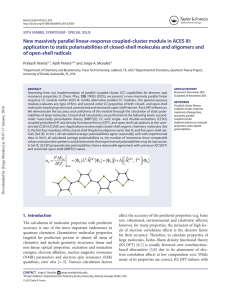Microsoft PowerPoint 2007
advertisement
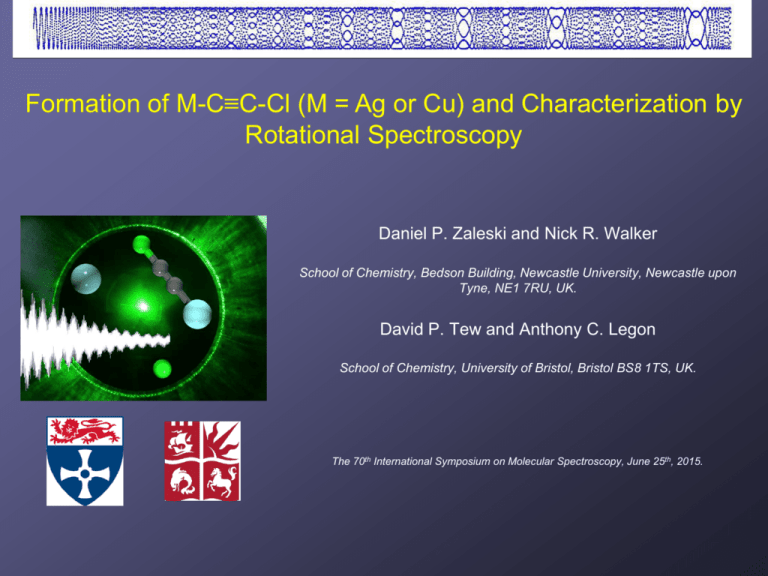
Formation of M-C≡C-Cl (M = Ag or Cu) and Characterization by Rotational Spectroscopy Daniel P. Zaleski and Nick R. Walker School of Chemistry, Bedson Building, Newcastle University, Newcastle upon Tyne, NE1 7RU, UK. David P. Tew and Anthony C. Legon School of Chemistry, University of Bristol, Bristol BS8 1TS, UK. The 70th International Symposium on Molecular Spectroscopy, June 25th, 2015. Chemical Themes The Basic Chemistry of Life Emerges from the Cold and the Dust Interstellar Chemistry and the Chemistry of Harsh Environments The carbon-rich chemistry of the interstellar medium has direct connections to many technologically important areas of chemistry Combustion chemical intermediates in flames ESO Despite inhospitable conditions, the full range of organic chemistry functional groups are produced in the places where planets form Orion Horsehead Nebula Electrical Discharge lightning planetary atmospheres Organic chemistry is prevalent in the hot core regions of star and planet formation Molecule formation requires a combination of gasphase, surface, and ice chemistry Unusual energy sources drive these chemical transformations (cosmic rays, EUV radiation, outflows) Nanotechnology fullerenes carbon nanotubes Discharge and Ablation Phys. Chem. Chem. Phys., 2014, 16, 25221-25228. Well known that DC electric discharges can produce small (un)stable molecules and hitherto unknown species Laser ablation of solids is another convenient method of producing plasmas Nd:YAG operating at 532 nm (pulse duration ~ 900 μs) is about 25 mJ/pulse: enough to ablate common metals If this plume immediately interacts with a gas of neutral molecules in its vicinity, fragmentation of the molecules can occur and the fragments can then undergo reactions. Chirped Pulse FTMW Spectroscopy Broadband spectrometers with instantaneous frequency coverage from 2-8 GHz, 6.5-18.5 GHz, 18.5-26 GHz, and 25 – 40 GHz have been constructed. Current Technology: AWG Digital Oscilloscope 24 Gs/s (12 GHz) 100 Gs/s (33 GHz) Phys. Chem. Chem. Phys., 2014, 16, 25221-25228. 1000x 1% CCl4 6 bar Ar 3M FIDs (100 hr) for normal species Weaker signals due to Cu/Cl hyperfine 1% CCl4 6 bar Ar 3M FIDs (100 hr) for the normal species X-AgCl Trends Species χaa (MHz) r(Ag-Cl) (Å) AgCl -36.4 2.281 -Ar -34.5 2.285 -Kr -33.8 2.277 Theory: -Xe -32.2 2.271 χaa = -31 MHz -H2O -32.3 2.272 -NH3 -29.8 2.263 -H2S -29.4 2.255 -C2H2 -28.9 2.266 -OC -28.2 2.255 -C2H4 -27.9 2.272 -C6H6 -24.1 2.240 r(Ag-Cl) = 2.218 Å χaa = -76.93(26) MHz rs(Ag-Cl) = 4.8729(12) Å Z. Naturforsch., 1978, 33a, 156-163. J. Chem. Phys., 2011, 135, 024315. Structure Determination Isotopic substitution produces small (and predictable) shifts in the rotational constants that are site-specific. (A,B,C) = (IA,IB,IC) (Aˊ,Bˊ,Cˊ) = (IAˊ,IBˊ,ICˊ) I = Σ mi∙ri2 |ra|,|rb|,|rc| Free from other assumptions about the molecular structure MP2/aug-cc-pVTZ-PP Am. J. Phys., 1953, 21, 17. Isotopologues M = Ag M = Cu Species Calc. Exp. Calc. Exp. nM12C12C35Cl 742.6 (n=107) 747.45619(16) 974.0 (n=63) 989.14990(73) nM12C12C35Cl 738.3 (n=109) 743.16060(19) 961.7 (n=65) 976.72539(78) nM12C12C37Cl 717.4 (n=107) 722.13078(21) 944.4 (n=63) 959.04302(38) nM12C12C37Cl 713.2 (n=109) 717.88218(28) 932.3 (n=65) - nM13C13C35Cl 738.6 (n=107) 743.37328(30) 971.2 (n=63) 986.25614(29) nM13C13C35Cl 734.3 (n=109) 739.03637(10) 958.9 (n=65) - Ag, Cu, C: CCSD(T)/aug-cc-pV5Z Cl: CCSD(T)/aug-cc-pV(5+d) J. Chem. Phys., 2010, 133, 174301. Properties M = Ag M = Cu Calc. r0 Calc. r0 r(M-C) (Å) 2.0187 2.015(14) 1.8383 1.812(16) r(C≡C) (Å) 1.2219 [1.2219] 1.2233 [1.2233] r(C-Cl) (Å) 1.6491 1.635(6) 1.6479 1.639(6) r(M∙∙∙Cl) (Å) 4.8897 4.8722(2) 4.7095 4.6736(6) difference between r0 and re for the triple bond in acetylene is 0.003 Å Ag, Cu, C: CCSD(T)/aug-cc-pV5Z Cl: CCSD(T)/aug-cc-pV(5+d) J. Chem. Phys., 2011, 134, 064119. Population Analysis It is difficult to discuss the precise mechanism by which these slightly exotic substances are formed, but it is well known that CCl, CCCl and CCl2 are among the products when a thermal plasma is sustained in CCl4/Ar mixtures. AgCCCl: CCl2: CCCl 1 : 1 : 0.1 The geometry of the 2Σ ground state of the CCCl radical has r(C‒C) = 1.267 Å, r(C‒Cl) = 1.634 Å and ∠ CCCl = 156.9°. The first and third of these lie midway between the corresponding values in ethyne and ethane, while r(C‒Cl) = 1.634 Å is very similar to the corresponding distance determined here for both Ag‒C≡C‒Cl and Cu‒C≡C‒Cl. J. Chem. Phys., 2003, 119, 1426-1432. J. Mol. Spectrosc., 2005, 232, 375-379. Plasma Chem. Plasma Proc., 2005, 109-119. Conclusions Demonstrated the usefulness of unbiased broadband survey spectra Identified a “pathway” for synthesizing MCCCl - M = Ag or Cu Would be interesting to further investigate the MCCCl binding properties - look at gas phase clusters coordinating to either side - M or Cl Look to synthesize longer chains Acknowledgments Engineering and Physical Sciences Research Council AWE (Aldermaston)

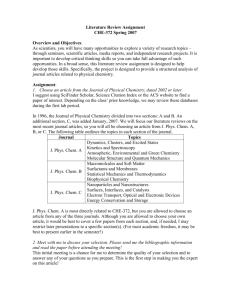

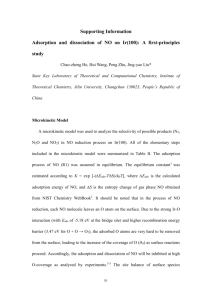
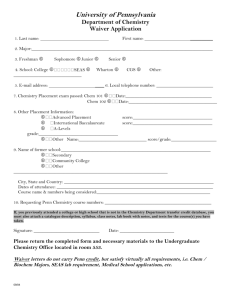

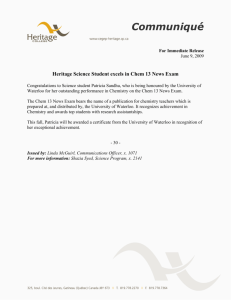
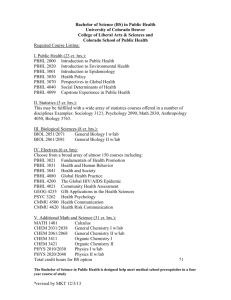

![This article was downloaded by: [Texas Technology University]](http://s2.studylib.net/store/data/011319099_1-76c042e265aa507435550dbe3204b505-300x300.png)
